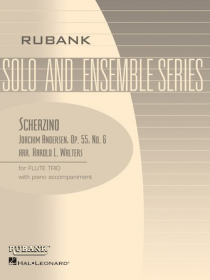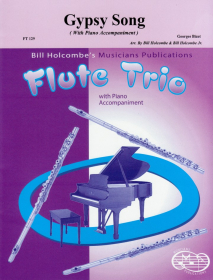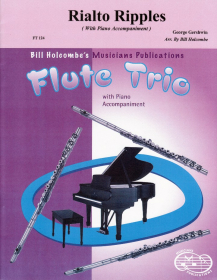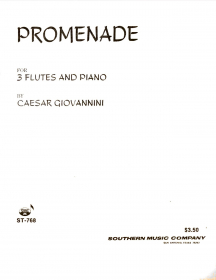3 Flutes & Piano
-
Albeniz, I :: Tango from Espana
Tango from Espana
Albeniz, I
Musicians Publications presents Isaac Albeniz's Tango from Espana arranged for flexible flute trio with piano by Bill Holcombe and Bill Holcombe Jr. Scored for 3 C flutes, this trio also includes an optional alto flute part to replace flute 3 when available for performance.
Isaac Albeniz was born in May 1860 in Catalonia, Spain. Albeniz achieved fame as a pianist and composer. A child prodigy, he made his debut at the age of 4 and his performance was so astonishing that some considered the possibility of fraud. At the age of 7 he gave concerts in Paris and at that same age wrote a Pasadoble that was played by military bands in Barcelona. A student of composition in various conservatories throughout Europe, his ambition was to study with Franz Liszt and he achieved that goal at the tender age of 18.
Concert tours around the world and in the USA ensued and he settled permanently in Paris and became great friends with Claude Debussy. The body of works created by Albania includes three operas, and many pianoforte classics, among them his masterwork Iberia & Espana (one of his more notable pieces composed in 1890 and contains the celebrated Tango , which is known as one of his most popular works). Espana is more delightful and accessible (much easier) than Iberia . It is made up of six piano pieces that subtly reflect the influences of the piano literature of the 19th century salon, and, like Iberia , the harmony and style of Impressionism, which Albeniz himself helped to create. Both works reveal characteristics of the highly individualized piano technique Albeniz developed from early childhood and perfected under the tutelage of Liszt.
-
Andersen, J :: Scherzino (Op. 55, No. 6)
Scherzino (Op. 55, No. 6)
Andersen, JHarold Walters presents this arrangement of Joachim Andersen's Scherzino (Op. 55, No. 6) for three flutes and piano. Includes score and parts.
-
Bach, JS :: Ave Maria
Ave Maria
Bach, JSMusicians Publications presents Ave Maria arranged for flute trio with piano by Bill Holcombe. This arrangement is easy-intermediate in difficulty. Scored for 3 C flutes, this arrangement also includes an optional alto flute part to substitute for flute 3 when available for performance.
French composer Charles Gounod, is probably best known for creating a melody that eventually was to become an Ave Maria that was to be sung over Johann Sebastian Bach s 'C Major Prelude from the Well-Tempered Klavier . Fanny Mendelssohn who was the sister of the famous composer, conductor and music historian (particularly on Bach) Felix, introduced the music of Bach to Gounod, who quickly became enamored with the old music. - Jay Fishman
-
-
Bizet, G :: Gypsy Song
Gypsy Song
Bizet, GMusicians Publications presents Georges Bizet s Gypsy Song' from 'Carmen' arranged for flute trio with optional piano by Bill Holcombe and Bill Holcombe Jr. Scored for 3 C flutes, this arrangement also includes an optional alto flute part to replace the 3rd flute, and an optional piano part.
Carmen' became Bizet s most celebrated work, although the premiere at the Opera Comique in Paris on March 3, 1875, was greeted by silence from its charter audience. Bizet died three months later, believing that his last opera had completely failed. By featuring smugglers, gypsies, factory girls, corporals, and cigarette smokers, Carmen' violated the chastity and lightweight fare of the typical Opera Comique productions. Despite its initial critiques, the quality of the music and the international soap opera appeal -- a tangled relationship amongst the beautiful, seductive Carmen, the army corporal Don Jose, and the famous matador Escamillo -- have continued to promote the work. Bizet s portrayal of Spanish life and music, and his understanding of the gypsies is instinctive and real. Upon hearing it in Paris, Peter I Tchaikovsky announced, In a few years 'Carmen will be the most popular opera in the world. With the 1875 Vienna production, just months after the disastrous Paris premiere, 'Carmen' was on its way to fulfilling Tchaikovsky's prediction. Other major composers of Bizet s era who praised 'Carmen were Brahms, Wagner, and Ravel.
- University of Texas Wind Symphony, 2017
-
-
Burgstahler, E :: Celestial Fantasy
Celestial Fantasy
Burgstahler, E
A reflective work that lends itself to romanticizing. Beautifully scored for 3 C Flutes and Piano.
-
Clarke, I :: Curves
Curves
Clarke, I
'Curves' was initially premiered by Ian Clarke in London, January 2011. This is a piece that explores the musical voice of the flute. The music leads to a limitless playground of feelings and extends the language of the flute.
-
Confrey, Z :: Dizzy Fingers
Dizzy Fingers
Confrey, ZMusicians Publications presents Zen Confrey s Dizzy Finger arranged for flute trio with piano by Bill Holcombe. Scored for 3 C flutes, this arrangement also includes an alto flute part to substitute for flute 3 when available for performance. 'Dizzy Fingers' is advanced in difficulty and 4:10 in duration.
This popular jazz tune by early American jazz and ragtime pianist, Zen Confrey, is a musical merry-go-round originally for piano. Holcombe s arrangement flows just as seamlessly as it would by a single piano player and keeps all the charm and pizazz of early American ragtime.
-
-
Dvorak, A :: Lullaby
Lullaby
Dvorak, A
A lovely small piece with equal interest for all parts. Scored for three C flutes with piano.
-
-
Gershwin, G :: Rialto Ripples
Rialto Ripples
Gershwin, GMusicians Publications presents George Gershwin's 'Rialto Ripples arranged for flute trio with piano accompaniment by Bill Holcombe. Scored for 3 C flutes, this trio also includes an alto flute part to substitute for flute 3 when available for performance.
Gershwin was born in Brooklyn, New York to Russian Jewish immigrant parents. His father, Morris (Moishe) Gershovitz, changed their family name to Gershwin sometime after emigrating from St. Petersburg, Russia. Gershwin's mother, Rosa Bruskin, also emigrated from Russia. She married Gershovitz four years later. George Gershwin was the second of four children. He first displayed interest in music at the age of ten, when he was intrigued by what he heard at a friend's violin recital. The sound and the way his friend played captured him. His parents had bought a piano for his older brother Ira, but to his parent s surprise and Ira's relief it was George who played it. He tried out various piano teachers for two years, and then was introduced to Charles Hambitzer by Jack Miller, the pianist in the Beethoven Symphony Orchestra. Hambitzer acted as George's mentor until Hambitzer's death in 1918. Hambitzer taught George conventional piano technique, introduced him to music of the European Classical tradition, and encouraged him to attend orchestral concerts. (At home following such concerts, young George would attempt to reproduce at the piano the music he had heard). He later studied with classical composer Rubin Goldmark and avant-garde composer-theorist Henry Cowell. His first job as a performer was as a piano pounder for Remick's, a publishing company on Tin Pan Alley. His 1917 novelty rag Rialto Ripples was a commercial success, and in 1919 he scored his first big national hit with his song Swanee . - Mark Nelson, 2007
-
Giovannini, C :: Promenade
Promenade
Giovannini, CCaesar Giovannini presents Promenade for 3 C flutes and piano.
American composer and pianist Caesar Giovannini was born in Chicago, Illinois. He began piano studies at the age of 5 and graduated from the Chicago Conservatory in 1948 with a Bachelor of Music and a Masters degree in composition. During World War II, he was pianist for the US Navy Band. In the 1950's, he worked largely in television, joining NBC in Chicago, then later ABC. His instrumental compositions include many works for concert band. Giovannini also played piano in many movie soundtracks in the 60's and 70's.
This short promenade for flute trio and piano is in a light and joyful style. Rich harmonies and lovely, playful melodies begin the work in a fanfare, which quickly bridges into several contrasting sections - quick, intertwined playing between the flutes, with longer, sustained melodic lines alternating.
-
Grundman, C :: Flutation
Flutation
Grundman, CClare Ewing Grundman (11 May 1913, Cleveland, Ohio - 15 June 1996, South Salem, New York) was an American composer and arranger, one of the 20th century's most prolific and highly respected composers for band. His lively, inventive compositions combined substance, playability and audience appeal, and are regarded as standard repertoires in the field.
Flutation for Flute Trio or Flute Choir, with Piano, is a short work that is reminiscent of a walk down a Parisian street during the day, exploring the countryside and the pastorale scenes. This work is perfect for intermediate players.
-
Harberg, A :: Fever Dreams
When an admired composer’s new work opens with the tempo 'as sultrily as possible,' or when it’s scored for 3 piccolos with piano, or when a piece composed and premiered during the height of a pandemic is titled FEVER DREAMS, one just has to listen to hear what it’s all about. Harberg crafts the piccolo trio to be steamy yet never shrill, and this tour de force is simply a 'must have' addition to the repertoire!
-
-
Hinchliffe, R :: The Elements
The Elements
Hinchliffe, R
Hinchliffe's The Elements lies in the broad tradition of well-written intermediate compositions on the lines of Rutter's Suite Antique or Vaughan Williams' Suite de Ballet. In four movements, The Elements invokes both traditional sounds and semi-jazz ideas to create a cohesive, melodic suite.
-
Holcombe, B :: Seville For A Day
Seville For A Day
Holcombe, BMusicians Publications presents Seville For a Day for flute trio with piano accompaniment composed by Bill Holcombe. Scored for 3 C flutes, an alto flute part is also included to substitute for flute 3 when available for performance.
The character of this piece brings performers and audience members alike into the city of Seville, Spain for a journey into the Spanish culture. This work is intermediate in difficulty and 2:10 in duration.
-
Holcombe, B :: Siesta In Seville
Siesta In Seville
Holcombe, BMusicians Publications presents Siesta in Seville for flexible flute trio by Bill Holcombe. Scored for 3 C flutes, this arrangement also includes an optional alto flute part to substitute for flute 3 when available for performance.
The character of this piece brings performers and audience members alike into the city of Seville, Spain for a journey into the Spanish culture. This work is intermediate in difficulty.





















